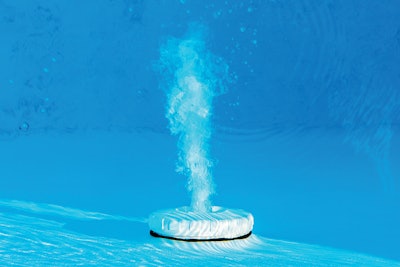
 Skip Phillips. The GENESIS co-founder and Master CBP, is one of the world's most renowned designers and builders of custom swimming pools, spas, and other forms of aquatic architecture.
Skip Phillips. The GENESIS co-founder and Master CBP, is one of the world's most renowned designers and builders of custom swimming pools, spas, and other forms of aquatic architecture.
Few people are as immersed in all facets of the pool industry as Skip Phillips. The GENESIS co-founder, Certified Master Pool Builder & Design Professional, and former owner of Questar Pools is known for his eye for design — but he started his career in the 1970s as a service technician.
Over the decades, he has seen the drastic improvements in automated pool equipment and how using this equipment can make life easier for pool builders, service and maintenance professionals, and homeowners alike.
“There are only three parts to a pool,” explains Phillips. “The design component, the structural component, and the mechanical component. Design tends to get all the focus, but the mechanical and structural aspects are a very important part of the equation.”
In the late 1970s and early 1980s, service and maintenance professionals understood the importance of water quality and sanitation, but the technology had not yet caught up to the need for consistency. “We would treat a pool and then come back a week later for the next service appointment and hope the pool hadn’t turned green,” Phillips says. Conversely, “if we put in enough chemicals to last seven days, we ran the risk of destroying the pool finish, causing swimmers’ eyes to burn, or other negative side effects of water chemistry.”
All of these variables — wind, rain, temperature, bather load — made it nearly impossible to control the water quality between services.
That all changed when manufacturers created the variable frequency drive (VFD) pool pump. “It was incredibly innovative,” says Phillips. “Most people didn’t know how to size a pump and a pipe. With a VFD pump, they could adjust the flow rate to match their specific equation.”
A standard, single-speed pool pump generally has either a six-hour or eight-hour turnover. That means the pool can be stagnant for up to 16 hours a day. Stagnant water is more likely to become the home of algae, mosquitoes, waterborne pathogens, and other unwanted and potentially dangerous bacteria.
A VFD pump, on the other hand, can run up to 24 hours a day economically, and be adjusted for various sanitation and filtration scenarios. There is little to no stagnation, which helps to achieve more balanced pool chemicals, pH levels, and overall healthier and clearer water.
An additional benefit of a VFD pump is that it makes alternative sanitizers more viable, due to the longer run times. Phillips uses ozone as an example. Unlike chlorine, “ozone has no life in the water. If the pump shuts off, there is no longer any residual.”
In his own pool, Phillips’ automated system is set to prioritize sanitation methods, starting with the chlorine-free option. When his pool sensors detect a need for more sanitizer, the first sanitizer that kicks in is ozone. When the ozone cannot keep up with the pool’s needs, the salt chlorine generator engages and makes chlorine internally. If even more sanitizer is needed, for example on a hot day or with a high bather load, liquid chlorine is added to the pool. Phillips’ automated system can also add acid as necessary to help maintain the proper pH level.
In addition to the creation of VFD pumps, other automated products have made the lives of pool owners and service professionals easier. When Phillips began his career in the pool industry, it was often the service professional’s responsibility to maintain the pool water level. Due to leakages, rainstorms, and other factors, this could be a surprisingly difficult task from week to week. The invention of autofill systems (which can monitor and control a pool’s water level) and overflow lines (which can manage and prevent water overflow through a drainage system) helped take this responsibility off the shoulders of service professionals.
These technological advancements, as well as others like automatic pool vacuums, actually help service professionals by reducing their liability exposure and improving the homeowner experience, Phillips explains. “It does not make their services obsolete! These technologies simply help the pool look better for longer between service appointments. My own pool has full automation, and I still hire a service company. I would never consider not having a service company,” he says.
For pool builders, whether they build concrete, vinyl, or fiberglass pools, Phillips recommends they consider including automated technology in their proposals. The client can elect not to purchase it, but the pool builder should strongly recommend it. Automation is great for the pool builder, too, because having balanced water means there should be less damage to the pool surface and pool finish. Pool builders should explain that there is a higher up-front cost to add automation, but that it saves much more money in the long-term. VFD pumps, in particular, are proven to be more energy efficient than single-speed pumps, which is appealing to the pool owner.
For service companies, Phillips explains that automation can be added to a pool at any time. “The biggest market in the industry right now is remodels,” he says. “There is ample opportunity to improve old mechanical systems on existing vessels.” Service companies, as long as they are licensed to do that type of work, can and should promote automation as part of their offerings.
“The manufacturers are producing equipment that is truly improving the pool owner experience,” says Phillips. “The technology is all there. It’s up to the pool builders and service companies to promote it and advance it.”
This article first appeared in the April 2023 issue of AQUA Magazine — the top resource for retailers, builders and service pros in the pool and spa industry. Subscriptions to the print magazine are free to all industry professionals. Click here to subscribe.





























